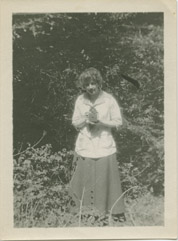Photo Archive, Gift of Tom Gatton Jr.
In response to recent controversy over the facts regarding the existence of a she-ape, Tom Gatton Jr. donated his father’s writings, oral histories, and photo archive to the IDOKCFR. He hopes that these documents will provide evidence that the she-ape is in fact not the love child of King Kong and Fay Wray as some myth-makers have suggested but in fact a real person, a true wonder of the world, born to science, lost to pain, and who lived to see the unfortunate filmic exploitations in Ingagi (1931) and King Kong (1933). Only a small portion of the photo archive has been made available to the public.
The photos were taken by cryptozoologist Tom Gatton during the period from 1905 to 1915 in Colorado Springs, CO. Tom Gatton and his partner Ted Thomas Harlon Moore were hired by “father” to track down his offspring, the now renowned she-ape that ran away in 1911 at age 14. In their attempt to find her, Gatton and Moore spent much time with the Nature Worshippers who claimed to be visited by the young she-ape every new moon. The Nature Worshippers, founded in 1911, venerated the she-ape creating totems, rituals, and offerings in her honor and to appease her wild ways. The founders believed that the she-ape (birth name, Heloise) presented a positive model for womankind and all primates. The existence of a simian-human hybrid provided a way to surpass the oppressions and restrictions placed on the purely human female. A manifesto, rumored to have been written by the founders, is yet to be found. Gatton is reported to have taken a single photograph of the she-ape during one of the ritual offerings. He was never allowed to return to the sacred dwellings. According to Gatton Junior’s correspondence, “father” never saw Heloise again.
Side Note: It has been said that “father” was the first biologist to experiment on interspecific hybridization of animals (with one known success inseminating female apes with human sperm in 1897). Reportedly, around 1912, his notes and data from these early experiments were sent to Russian biologist Ilya Ivanovich Ivanov at the Askania-Nova Natural reserve. The data is presumed to be sealed in a Soviet archive.






